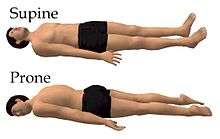Supine position

The supine position (/səˈpaɪn/ or /ˈsuːpaɪn/) means lying horizontally with the face and torso facing up, as opposed to the prone position, which is face down. When used in surgical procedures, it allows access to the peritoneal, thoracic and pericardial regions; as well as the head, neck and extremities.[1]
Using anatomical terms of location, the dorsal side is down, and the ventral side is up, when supine.

Semi-supine
In scientific literature "semi-supine" commonly refers to positions where the upper body is tilted (at 45° or variations) and not completely horizontal.[2]
Relation to sudden infant death syndrome
The decline in death due to sudden infant death syndrome (SIDS) is said to be attributable to having babies sleep in the supine position.[3] It is believed that in the prone position babies are more at risk to re-breathe their own carbon dioxide. Because of the immature state of their central chemoreceptors, infants do not respond to the subsequent respiratory acidosis that develops.
Obstructive Sleep Apnea
Obstructive Sleep Apnea (OSA) is a form of sleep apnea that occurs more frequently and the most severe when individuals are sleeping in the supine position. Studies and evidence show that OSA related to sleeping in the supine position is related to the airway positioning, reduced lung volume, and the inability of airway muscles to dilate enough to compensate as the airway collapses.[4] With individuals who have OSA, many health care providers encourage their patients to avoid the supine position while asleep and sleep laterally or sleep with the head of their up in a 30 or 45 degree angle.[5]
See also
References
| Wikimedia Commons has media related to Supine. |
- ↑ Rothrock, J. C. (2007) Alexander's Care of the Patient in Surgery 13th Ed. Mobsy Elsevier: St Louis, Missouri. p. 148.
- ↑ Petropoulou, E; Lancellotti, P; Piérard, LA (2006). "Quantitative analysis of semi-supine exercise echocardiography--influence of age on myocardial Doppler imaging indices". Acta Cardiologica. 61 (3): 271–7. PMID 16869446.
- ↑ Marcarelli, Rebekah (3 May 2014). "Sudden Infant Death Syndrome Could Be Prevented By Making Sure Baby Sleeps On Back". hngn.com. Headlines & Global News. Retrieved 25 March 2016.
- ↑ Joosten, Simon A.; O'Driscoll, Denise M.; Berger, Philip J.; Hamilton, Garun S. (2014-02-01). "Supine position related obstructive sleep apnea in adults: pathogenesis and treatment". Sleep Medicine Reviews. 18 (1): 7–17. doi:10.1016/j.smrv.2013.01.005. ISSN 1532-2955. PMID 23669094.
- ↑ Tuomilehto, Henri; Seppä, Juha; Partinen, Markku; Uusitupa, Matti (2009-07-01). "Avoiding the Supine Posture during Sleep for Patients with Mild Obstructive Sleep Apnea". American Journal of Respiratory and Critical Care Medicine. 180 (1): 101–102. doi:10.1164/ajrccm.180.1.101a. ISSN 1073-449X.